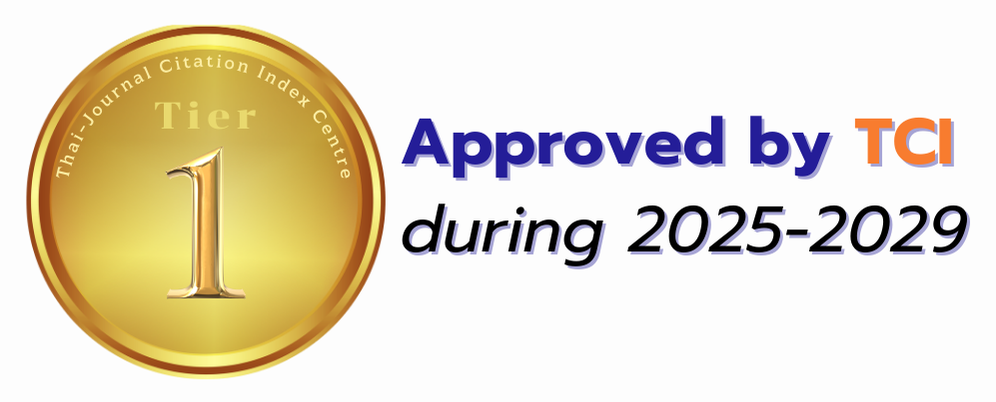Influence of disturbances on aboveground biomass of deciduous dipterocarp forest in Huay Tak-Teak biosphere reserve, Lampang province
DOI:
https://doi.org/10.34044/tferj.2025.9.1.6179Keywords:
biodiversity, forest structure, non-timber forest product, permanent plot, utilizationAbstract
Background and Objectives: Tropical deciduous forests (TDFs) play a crucial role in providing ecosystem services. Forest fires during the dry season make TDFs more sensitive to changes compared to evergreen forests. Of these, understanding biomass in TDFs is essential for assessing the global carbon budget. However, human activities are rapidly transforming the Earth's forest ecosystems through changes in land use and climate. These changes can impact the structure, dynamics, and diversity of TDFs. While numerous studies have focused on diversity metrics, research on the effects of human activities on forest structure, species composition, and aboveground biomass (AGB)—particularly within biosphere reserves—remains limited. This study examines forest structure, species composition, and AGB, with a focus on the impact of disturbances within a deciduous dipterocarp forest (DDF) in the Huay Tak-Teak Biosphere Reserve. Since DDFs receive less attention compared to other forest types in Thailand, this study aims to address three key questions: (1) What is the current state of forest structure, diversity, and AGB in permanent plots of DDFs? (2) How do these variables differ between core and buffer areas? and (3) What is the correlation between AGB and forest structural attributes (such as density and basal area)?
Methodology: In 2024, two permanent 1-hectare (ha) plots were established: one in the core area, where human activity is prohibited, and the other in the buffer zone, where human activity occurs. Each plot was subdivided into 25 subplots (20 m × 20 m). All trees with a diameter at breast height (DBH) of at least 1 cm were tagged, measured, and identified to the species level following standard protocols. To assess the effects of disturbances, we analyzed quantitative characteristics—including forest structure, species composition, and aboveground biomass—and compared these variables between the core and buffer zones. Differences in diversity were examined using non-metric multidimensional scaling (NMDS) and PERMANOVA. Additionally, we assessed the relationship between AGB, tree density, and basal area using Spearman’s correlation.
Main results: Results indicated significant differences in general forest characteristics between the core and buffer areas (p < 0.001). Tree density and basal area (³ 1 cm DBH) were 1,626 individual ha-1 and 27.35 m2 ha-1 in the core area and 2,470 individual ha-1 and 20.98 m2 ha-1 in the buffer zone, respectively. The core area displayed old-growth forest characteristics, with a higher basal area, while the buffer zone exhibited secondary forest features, characterized by a high density of small trees. Natural regeneration, based on diameter class distribution, exhibited a reverse J-shaped distribution in the core area, indicating a stable population structure, whereas a unimodal distribution was observed in the buffer zone, suggesting a disturbed forest with fewer young trees. Species richness was higher in the core area than in the buffer zone. The core area contained 76 species, 63 genera, and 30 families, with the five most dominant species (based on the importance value index) being Albizia lebbeck, Shorea obtusa, Dalbergia oliveri, Pentacme siamensis, and Dipterocarpus obtusifolius. In contrast, the buffer zone had 48 species, 42 genera, and 27 families, with the dominant species being Dipterocarpus obtusifolius, Shorea obtusa, Aporosa villosa, Tristaniopsis burmanica var. rufescens, and Gluta usitata. Species diversity, based on the Shannon-Wiener Index, was 3.54 in the core area and 2.27 in the buffer zone, indicating a significant difference in diversity. NMDS followed by PERMANOVA, revealed distinct species compositions between the core and buffer areas (p < 0.001), likely due to disturbances. Total AGB was 204.20 t ha-1 in the core area and 127.89 t ha-1 in the buffer zone, with the higher AGB in the core area reflecting a more intact forest ecosystem. In the buffer zone, Dipterocarpus obtusifolius contributed approximately 44% of the total AGB, making it the dominant biomass-accumulating species. In the core area, Albizia lebbeck was the highest biomass-accumulating species, contributing 22% of the total AGB. Finally, Spearman’s correlation analysis revealed that basal area showed a significant positive correlation with AGB in both the core and buffer areas (R > 0.8, p < 0.001), whereas tree density exhibited no significant relationship with AGB. Therefore, conservation and management efforts should prioritize dominant species such as Dipterocarpus obtusifolius, Shorea obtusa, Pentacme siamensis, and Albizia lebbeck to maintain AGB and carbon stock in the Huay Tak-Teak Biosphere Reserve.
Conclusion: These findings suggest that human-induced disturbances significantly impact plant community characteristics in the DDF, with the buffer zone exhibiting features of a secondary forest with irregular regeneration. The results highlight the crucial role of tropical deciduous forests in accumulating AGB and conserving biodiversity within Thailand’s forest ecosystems. While the findings indicate that this biosphere reserve may effectively conserve overall plant diversity, they also reveal key ecological shifts, such as a substantial loss of AGB due to the lower presence of large trees in the buffer zone. If this pattern is widespread across tropical forest reserves, it could hinder efforts to preserve forest structure and essential ecosystem services, such as carbon storage. Establishing long-term monitoring programs could enhance the assessment of AGB trends within the reserve over time, contributing to more informed conservation and management strategies.
Downloads
References
Bullock, S. H., H. A. Mooney & E. Medina. 1995. Seasonally dry tropical forests. Cambridge: Cambridge University Press.
Bunyavejchewin, S., P. J. Baker & S. J. Davies. 2011. Seasonally dry tropical forests in continental Southeast Asia: structure, compositon and dynamics. pp. 9–35. In Mcshea, W., S. J. Davies & N. Bhumpakphan (eds.) The ecology and conservation of seasonally dry forests in Asia. Smithsonian Institution Scholarly Press, Washington (DC).
Bunyavejchewin, S., J. V. LaFrankie, P. J. Baker, M. Kanzaki, P.S. Ashton & T. Yamakura. 2003. Spatial distribution patterns of the dominant canopy dipterocarp species in a seasonal dry evergreen forest in western Thailand. Forest Ecology and Management 175(1-3): 87–101. https://doi.org/10.1016/S0378-1127(02)00126-3
Castillo-Campos, G., G. Halffter & C. E. Moreno. 2008. Primary and secondary vegetation patches as contributors to floristic diversity in a tropical deciduous forest landscape. Biodiversity and Conservation 17: 1701–1714. https://doi.org/10.1007/s10531-008-9375-7
Chaisunthornkitti, T., K. Duangsathaporn, P. Prasomsin & A. Y. Omule. 2013. Vegetation dynamics over a 10-year period in a dry dipterocarp forest in Mae-Huad sector, Ngao demonstration forest, Lampang province. Thai Journal of Forestry 32: 152–161. (in Thai)
Chave, J., C. Andalo, S. Brown, M. A. Cairns, J. Q. Chambers, D. Eamus, H. Fölster, F. Fromard, N. Higuchi & T. Kira. 2005. Tree allometry and improved estimation of carbon stocks and balance in tropical forests. Oecologia 145: 87–99. https://doi.org/10.1007/s00442-005-0100-x
Chave, J., D. Coomes, S. Jansen, S. L. Lewis, N. G. Swenson & A. E. Zanne. 2009. Towards a worldwide wood economics spectrum. Ecology Letters 12(4): 351–366. https://doi.org/10.1111/j.1461-0248.2009.01285.x
Chave, J., M. Réjou‐Méchain, A. Búrquez, E. Chidumayo, M. S. Colgan, W. B. C. Delitti, A. Duque, T. Eid, P. M. Fearnside & R. C. Goodman. 2014. Improved allometric models to estimate the aboveground biomass of tropical trees. Global Change Biology 20(10): 3177–3190. https://doi.org/10.1111/gcb.12629
Curtis, J. T. & R. P. McIntosh. 1950. The interrelations of certain analytic and synthetic phytosociological characters. Ecology 31(3): 434–455. https://doi.org/10.2307/1931497
Gardner, S., P. Sidisunthorn & V. Anusarnsunthorn. 2000. A field guide to forest trees of northern Thailand. Bangkok: Kobfai Publishing Project.
Kent, M. 2011. Vegetation description and data analysis: a practical approach. West Sussex: John Wiley & Sons.
Lamotte, S., J. Gajaseni & F. Malaisse. 1998. Structure diversity in three forest types of north-eastern Thailand (Sakaerat Reserve, Pak Tong Chai). Biotechnologie, Agronomie, Société et Environnement 2(3): 192–202.
Larpkern, P., M. Eriksen & P. Waiboonya. 2017. Diversity and uses of tree species in the deciduous dipterocarp forest, Mae Chaem District, Chiang Mai Province, Northern Thailand. Naresuan University Journal: Science and Technology (NUJST) 25(3): 43–55.
Li, J., Z. Ren & Z. Zhou. 2006. Ecosystem services and their values: a case study in the Qinba mountains of China. Ecological Research 21: 597–604. https://doi.org/10.1007/s11284-006-0148-z
Luyssaert, S., E. D. Schulze, A. Börner, A. Knohl, D. Hessenmöller, B. E. Law, P. Ciais & J. Grace. 2008. Old-growth forests as global carbon sinks. Nature 455(7210): 213–215. https://doi.org/10.1038/nature07276
R Core Team. 2025. R: A language and environment for statistical computing. R Foundation for Statistical Computing, Vienna, Austria. Available source: https://www.R-project.org/. (Accessed: September 12, 2024)
Majumdar, K., U. Shankar & B. K. Datta. 2012. Tree species diversity and stand structure along major community types in lowland primary and secondary moist deciduous forests in Tripura, Northeast India. Journal of Forestry Research 23(4): 553–568. http://dx.doi.org/10.1007/s11676-012-0295-8
Manokaran, N., J. V. Lafrankie, K. M. Kochummen, E.S. Quah, J. F. Klahn, P. S. Ashton, S. P. Hubbell & H. T. Chan. 1990. Methodology for the fifity hectare research plot at Pasoh Forest Reserve. Malaysia: Research Pamphlet – Forest Research Institute Malaysia.
Marod, D., U. Kutintara, C. Yarwudhi, H. Tanaka & T. Nakashisuka. 1999. Structural dynamics of a natural mixed deciduous forest in western Thailand. Journal of Vegetation Science 10(6): 777–786. https://doi.org/10.2307/3237302
Meng, J., Y. Lu, X. Lei & G. Liu. 2011. Structure and floristics of tropical forests and their implications for restoration of degraded forests of China's Hainan Island. Tropical Ecology 52(2): 177–191.
Mohandass, D., A. C. Hughes, B. Mackay, P. Davidar & T. Chhbra. 2016. Floristic species composition and structure of a mid-elevation tropical montane evergreen forests (sholas) of the western ghats, southern India. Tropical Ecology 57(3): 533–543.
Mohanta, M. R., A. Mohanta, U. Mohapatra, R. C. Mohanty & S. C. Sahu. 2020. Carbon stock assessment and its relation with tree biodiversity in Tropical Moist Deciduous Forest of Similipal Biosphere Reserve, Odisha, India. Tropical Ecology 61(4): 497–508. https://doi.org/10.1007/s42965-020-00111-8
Murphy, P. G. & A. E. Lugo. 1986. Ecology of tropical dry forest. Annual review of ecology and systematics 67–88. https://doi.org/10.1146/annurev.es.17.110186.000435
Oksanen, J., F. G. Blanchet, M. Friendly, K. Roeland, P. Legendre, D. McGlinn, P. R. Minchin, R. B. O'Hara, G. L. Simpson, P. Solymos, et al. 2020. Vegan: Community Ecology Package. R package version 2.5–7. Available source: https://CRAN.R-project.org/package=vegan (Accessed: September 12, 2024)
Pandey, S. K. & R. P. Shukla. 2001. Regeneration strategy and plant diversity status in degraded sal forests. Current Science 95–102.
Pongpattananurak, N. 2014. Prioritizing forest complexes of Thailand using landscape metrics. Thai Journal of Forestry 33(2): 61–76. (in Thai)
San-José, M., L. Werden, C. J. Peterson, F. Oviedo-Brenes & R. A. Zahawi. 2021. Large tree mortality leads to major aboveground biomass decline in a tropical forest reserve. Oecologia 197(3): 795–806. https://doi.org/10.1007/s00442-021-05048-w
Shorohova, E., T. Kuuluvainen, A. Kangur & K. Jõgiste. 2009. Natural stand structures, disturbance regimes and successional dynamics in the Eurasian boreal forests: a review with special reference to Russian studies. Annals of Forest Science 66(2): 1–20. https://doi.org /10.1051/forest/2008083
Stephenson, N. L., A. J. Das, R. Condit, S. E. Russo, P. J. Baker, N. G. Beckman, D. A. Coomes, E. R. Lines, et al. 2014. Rate of tree carbon accumulation increases continuously with tree size. Nature 507(7490): 90–93. https://doi.org/10.1038/nature12914
Thai-utsa, B. 1968. Structural characteristics of dry dipterocarp forest, Hauy-Thark, Ngao, Lampang. M. S. thesis, Faculy of Forestry, Kasetsart University, Bangkok, Thailand. (in Thai)
Thammanu, S. 2021. Effect of community forest management on biodiversity and utilization of non-timber forest products in northern Thailand. Ph.D. dissertation, Graduate school, Seoul National University, Seoul, South Korea.
Thammanu, S., D. Marod, H. Han, N. Bhusal, L. Asanok, P. Ketdee, N. Gaewsingha, S. Lee & J. Chung. 2021. The influence of environmental factors on species composition and distribution in a community forest in Northern Thailand. Journal of Forestry Research 32(2): 649–662. https://doi.org/10.1007/s11676-020-01239-y
Tilman, D. & S. Pacala. 1993. The maintenance of species richness in plant communities. Pp 13–25. In: Ricklefs R, Schluter D (eds) Species diversity in Ecological communities: historical and geographical perspectives. The University of Chicago Press, Chicago.
van Der Velden, N., J. W. F. Slik, Y.-H. Hu, G. Lan, L. Lin, X. Deng & L. Poorter. 2014. Monodominance of Parashorea chinensis on fertile soils in a Chinese tropical rain forest. Journal of Tropical Ecology 30(4): 311–322. https://doi.org/10.1017/S0266467414000212
Whitmore, T. C. 1990. An introduction to tropical rain forests. Oxford: Clarendon Press.







.png)





